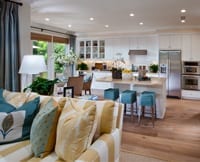Eight new residential design trends turned heads at the annual Best in American Living Awards (BALA), presented by the National Association of Home Builders (NAHB) at the 2012 International Builder’s Show. One of the most-buzzed-about was a changing approach to “the family triangle.” The term refers to the three activities and spaces that generally draw families together: cooking (kitchen), eating (dining room), and relaxation (living/family/great room). The latest approach creates spaces that link these activities, as a traditional great room would, while also allowing private nooks.
The family triangle continues the movement away from formal, compartmentalized space toward more open living. One of the judges, Heather McCune, Marketing Director for Bassenian Lagoni Architects of Newport Beach, CA, said demand for such spaces is strong across all buyer profiles, in all regions of the country.

Photo: Bassenian Lagoni Architects
More than a Big Room
But the family triangle is more than just a big room. It modifies the conventional open floor plan by including “different areas for different tasks and levels of comfort,” says Amy Martino, principal of Building Site Synergy, an architectural firm in Media, PA. “It should be able to accommodate large groups, but should also feel comfortable if just one person is in the room.” For instances, eliminating the living room and adding a flex space or den near the kitchen and family room allows for privacy when needed, but let’s family members in different parts of the space easily interact with one another.
McCune isn’t surprised at this trend. In fact, she sees adaptable spaces as a sign of the times. “We’re looking to shrink the home’s overall footprint, while allocating space in the home so it lives bigger. It seem natural in a post-recessionary period.”
Emphasizing the Practical
To help the home live bigger, a plan that emphasizes the family triangle will eliminate spaces that aren’t needed and more practical touches to spaces that are. Case in point: don’t count on hallways sticking around. “The spaces that people never use are gone.” says McCune.
What you’re more likely to see is a kitchen island with lots of convenient storage and an island sink that faces the living space. The expansive island provides useful workspace for one or more cooks, while also creating a “safe zone” that separates the cook from children and guests. When no one is cooking, the island can also serve as a place to study or work on a project. Incorporating varying counter heights makes the island comfortable for family members and guests of different ages, heights and levels of ability.
A nearly universal element of the family triangle? “Some kind of kitchen command center,” says McCune. Often a small dedicated desk area works as a place for bill paying or where children can do homework.
Defining Spaces
One challenge when designing a family triangle revolves around how to create small pockets of relative privacy in the midst of all that space. According to Martino, designers use architectural elements like ceiling treatments, columns and softfits to create distinct zones for reading, working or simply relaxing, while also retaining the openness of the overall space.
Lighting plays an extremely important role, too. Different levels of lighting with dimmers can accommodate different tasks and completely change the room’s ambience. Layered lighting – overhead, sconces, accent lighting, task lighting, and specialty lighting such as a chandelier or colorful pendant – can be adjusted, used separately, or as a group to create a sense of place within the space.